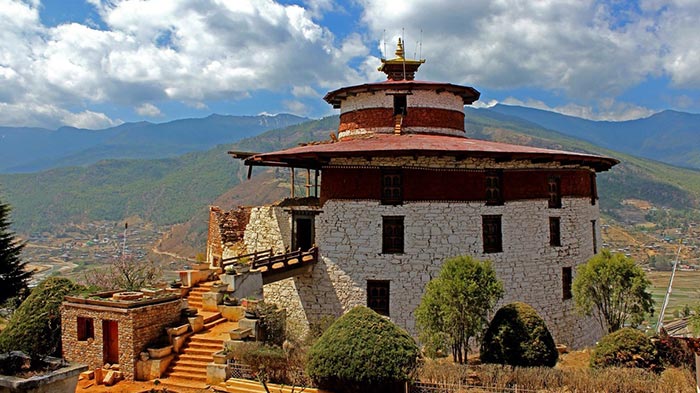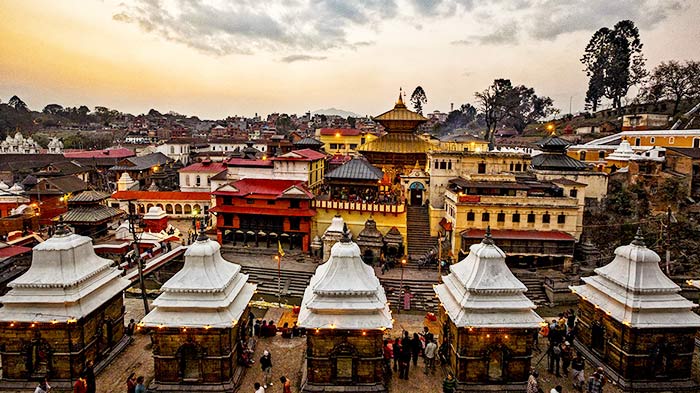
Unique Experiences for Visiting Nepal Bhutan Tibet
From the stunning sights of Mt. Everest to the breathtaking views from the Dochula Pass and the exotic jungles of Chitwan, this region of the Himalayas is among the almost-mystical destinations that are dreamed of by travelers all over the world. Rich in history, culture, arts, religion and architecture, these are all unique places in themselves, and are the perfect places to experience the rich Himalayan cultures. Sanctuaries of pristine natural forests, thundering rivers, great mountain vistas, and countless lakes and valleys, travels there offer opportunities for adventurous hikes, religious and cultural monastery experiences, and colorful festivals. You have the chance to meet locals and monks, try out local cuisines, and get to know more about these very unique peoples.
 (Simple click to enlarge the map)
(Simple click to enlarge the map)
Map of Tibet Nepal Bhutan Tourist Attractions
Unique Sites For Bhutan Tourism
Taktsang Monastery
Set high on the cliff above the Paro valley, this unique monastery is believed to be on the site where the Guru Rinpoche landed when he came to Bhutan on a flying tigress. The monastery is 800 meters above the valley floor, and is perched on a ledge less than 10 meters wide. ornately designed, the temple houses some of Bhutan’s greatest Buddhist artworks, and is the site of the legendary meditation caves of Rinpoche.
Punakha Dzong
Unarguably the most beautiful monastery in the country, Punakha Dzong sits on the confluence of the Mo Chhu and Pho Chhu rivers, set in some of Bhutan’s most beautiful countryside. The second monastery to be built in Bhutan, it was the seat of government and is the winter residence of the dratshang, the official monastic body of Bhutan.
National Museum of Bhutan
High above the city of Paro sits the National Museum of Bhutan, a former watchtower that once protected the local Paro Dzong from attack. It was unused for decades until it was renovated in 1968 to house the museum. The shape of this round building is said to have been designed to resemble a conch shell, and the museum contains an impressive collection of Buddhist Thangkas, both ancient and modern, several dozen ancient festival masks, an egg that was reputedly laid by a mule, and a horse horn that is attributed to belong to Guru Rinpoche, as well as many other delightful and interesting relics.
 You can appreciate the exhibits at National Museum of Bhutan
You can appreciate the exhibits at National Museum of Bhutan
Royal Manas National Park
A royal national park, Manas is Bhutan’s oldest wildlife sanctuary, and is considered to be the country’s conservation showpiece. In a country that values happiness over wealth, it has been preserved as a sanctuary for the decimated wildlife of the Himalayas and a genetic repository for the valuable local plants. With habitats including lowland tropical forests to permanent ice fields, the park is home to hundreds of endangered species, including Bengal tigers, Asian elephants, pygmy hogs, and the very rare golden langur.
Gangteng Monastery
Gangteng Monastery is a gompa of the Nyingma sect of Tibetan Buddhism, and is over 400 years old. The largest Nyingma monastery in Bhutan, it is the primary seat of the Gangteng incarnation line, the Pema Lingpa. Located in central Bhutan in the Wangdue Phodrang district, the land surrounding the monastery is a haven for the rare black-necked cranes that visit Bhutan to roost. The most unique thing about this site is the flights of the cranes. Every year when they arrive from Tibet, they circle the roof of the monastery three times before landing. And when it is time to fly back again, they do the same three circles of the roof before heading off north.
Motithang Takin Preserve
Located in the Motithang District of Thimphu, the Takin Preserve is dedicated to the preservation of one single animal, the Bhutan Takin. Also known as the “cattle chamois” or “gnu goat”, this strange, ox-looking creature is the national animal of Bhutan. While it closely resembles a musk ox, it shares more genetic makeup with sheep, making it a rare example of convergent evolution. The preserve was originally a zoo, and when it was converted, the animals refused to wander anywhere outside the original zoo grounds. The Takin is reputed to have been created by Tibetan saint, Drukpa Kunley, when asked by the people of Bhutan to perform a miracle.
Unique Sites for Nepal Tourism
Chitwan National Park
The first National Park in Nepal, Chitwan is located in the inner Terai lowlands in south-central Nepal. Now a World heritage Site, the park is devoid of all human habitation, and is the home to around 82 Bengal tigers, over 600 rhinos, leopards, crocodiles, and hundreds of other local indigenous species. The park is considered to have the highest population of sloth bears in the world, and is a mating ground for elephants that wander across the border from the Valmiki National Park in India in search of mates.
Pashupatinath Temple
The Pashupatinath Temple is a sacred Hindu temple set on the banks of the Bagmati River, just northeast of the Kathmandu Valley. One of the most sacred Hindu temples in Nepal, it serves as the seat of the Nepali national deity, Lord Pashupatinath, and is a sprawling complex of temples, ashrams, images, and inscriptions that were raised over a number of centuries. On the day of the temple’s major festival, Maha Shivaratri, more than 800,000 devotees visit the site to pray and celebrate.
 Pashupatinath Temple is one of the most sacred Hindu temples set on the banks of the Bagmati River in Nepal
Pashupatinath Temple is one of the most sacred Hindu temples set on the banks of the Bagmati River in Nepal
Swayambhunath
An ancient example of religious architecture, Swayambhunath sits atop a hill in the Kathmandu Valley, just west of the city. The name is Tibetan for “Sublime Trees”, and it was named for the dozens of varieties of trees that are found on the hill. The site is one of the most sacred Buddhist sites in Nepal, it occupies a very central position in the Buddhist Newar school. Part of the site is a large stupa, which has Buddhas eyes and eyebrows painted on all four sides, while the number “1” is painted between the eyes to resemble a nose.
Sagarmatha National Park
Sagarmatha National Park is a protected area of the Himalayas that is dominated by the mighty Mount Everest. Lying in the Solukhumbu District of Nepal, the park ranges in elevation from 2,845 meters to 8,848 meters, at the summit of Everest. Sagarmatha has been identified as a major important area for birds by Birdlife International, and is included in the Sacred Himalayan Landscape Conservation Area. It is also the home of the famous Sherpa people, whose lives are closely interwoven with the teachings of Buddhism, and the area contains some of the most renowned of Nepal’s monasteries.
Mount Everest Base Camp
One of two Base Camps at the foot of Mount Everest, the Southern Base Camp in Nepal was the jumping-off point for the most famous climb of all time, the Hillary/Tensing Expedition that reached the summit of Everest. The base camp is visited by thousands of trekkers every year, and is one of the most popular treks in the world. Sitting at 5,364 meters above sea level, it is over 150 meters higher than its Tibetan counterpart, although the trip to get there is a lot harder than in Tibet.
Unique Sites for Tibet Tourism
Potala Palace
Set high atop Moburi, the Red Hill, in the Tibetan capital of Lhasa sits the world famous Potala Palace. This beautiful, red and white structure is one of the most important buildings in Tibet, and was the former seat of government. The site was an early fortress built by Tibetan King, Songtsen Gampo, in around 637 AD. This huge building has stone walls three meters thick, has thirteen stories of buildings, and contains over 1,000 rooms, 10,000 shrines, and 200,000 statues. The palace looks down on Lhasa from its perch 300 meters above the city.
Jokhang Temple
Also known as the Qoikang Monastery, Jokhang Temple is the most sacred and revered building in Tibet. It is maintained by the Gelug school of Tibetan Buddhism, but worshippers from all sects come there to walk the holy kora around the temple, and pray and prostrate themselves before its doors. The temple was founded in the Wang Dynasty, over 1300 years ago, and contains a priceless statue of Buddha that was brought there from China by Songtsen Gampo’s wife to be, the beautiful Princess Wencheng. The temple is set in the middle of the Tibetan capital, and is surrounded by the famous Barkhor Street, an open-air market which doubles as the route of the Jokhang kora.
Holy Mount Kailash
Far out in the west of Tibet lies a lonely mountain that stands high above the arid plains. Holy Mount Kailash is the most sacred mountain in the world, and revered by four different religions. Holy in Buddhism, Hinduism, Jainism, and Bonism, the mountain is believed to be the center of the world, the earthly embodiment of Mt. Meru, the home of Shiva and Demchok, and the axis mundi, or cosmic axis of the universe. Every year, the mountain is the site of a pilgrimage for thousands of people, who travel hundreds or even thousands of kilometers to pray and celebrate at Mt. Kailash during the Saga Dawa festival. During the festival, the flagpole is taken down, and the flags are replaced before it is re-erected, and many thousands of pilgrims and tourists take the long walk around the 52-kilometer Kailash kora.
 Holy Mount Kailash is the ultimate destination for Buddhists
Holy Mount Kailash is the ultimate destination for Buddhists
Yamdrok Lake
One of the three largest sacred lakes in Tibet, along with Namtso Lake and Lake Manasarovar, Yamdrok Lake is a freshwater lake surrounded by many snow-capped mountains and fed by dozens of small streams. The lake is significant in Tibetan Buddhism as being guarded by the goddess Dorje Gegkyi Tso, and is one of the “Great Wrathful Lakes”. The largest lake in southern Tibet, it is believed that if the lake waters dry up, Tibet will become an uninhabitable wasteland.
Rongbuk Monastery
Renowned as the highest monastery in the world, at 4,980 meters above sea level, Rongbuk Monastery is a Buddhist monastery of the Nyingma Sect. While it has one of the best views of Mount Everest in Tibet, it is also a sacred site to the Sherpa people, who live in the shadow of the great mountain, and an important site for pilgrimage. It was also a regular staging point for the expeditions to scale Mt. Everest, which lies a few kilometers to the south. From the monastery, it is an 8km walk to the Northern Base Camp of Mt. Everest.
If you are planning to enjoy a trip to Tibet Nepal Bhutan, yet have no ideas of how to sort it out the details, no worries! We would like to hear your tour plan and offer free professional consultancy and viable solutions. Please feel free to contact us.

Kham Sang is responsible and honest with more than six years of guide experience in Tibet.She has strong interpersonal skills and can communicate effectively with tourists.


.jpg)


0 Comment ON "Unique Experiences for Visiting Nepal Bhutan Tibet"